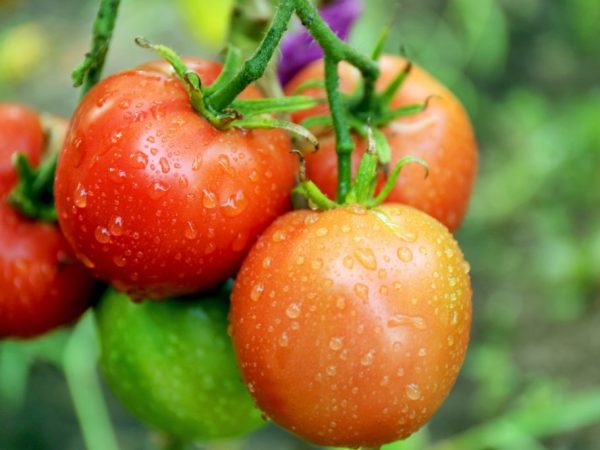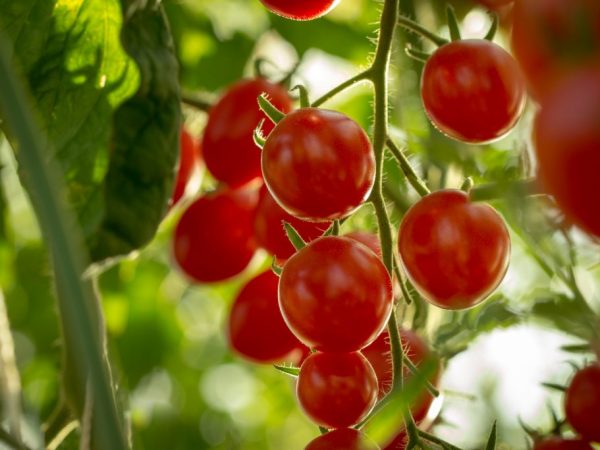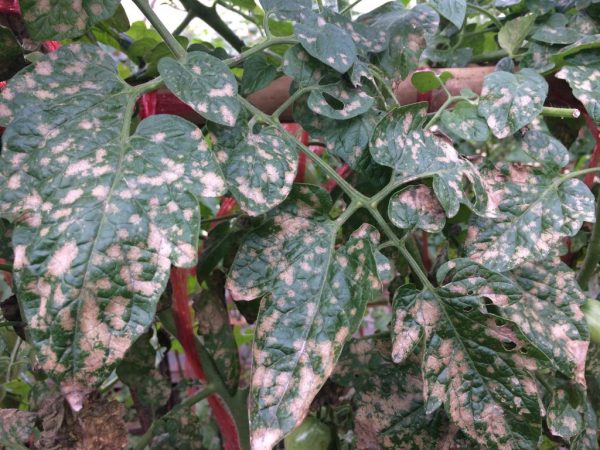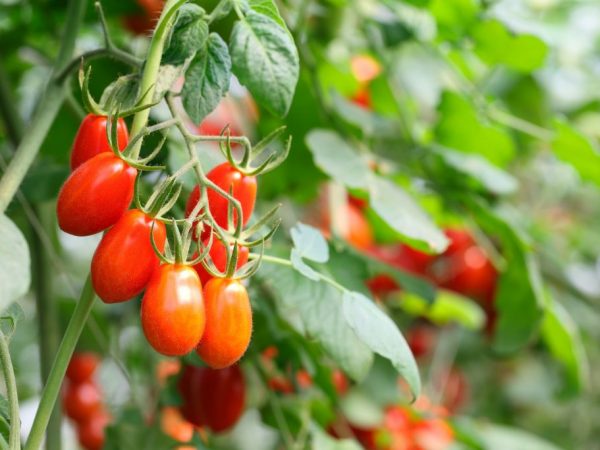Growing and the benefits of a tomato
Tomatoes are vegetables from the Solanaceae family and are eaten and grown all over the world. In the article you can read about the peculiarities of growing tomatoes, learn how to properly care for the crop, as well as why fresh tomatoes are so useful, is there any harm from eating them.
- Growing conditions
- In the greenhouse
- In the open field
- Growing rules
- Seedling preparation
- Organization of watering
- Top dressing
- Pruning bushes
- Loosening
- Hilling
- Bush formation
- Tying
- Diseases of tomatoes
- Signs of the disease
- Varieties of tomatoes
- Plum tomatoes
- Meaty varieties
- Versatile tomatoes
- The benefits of tomatoes
- Benefits for the heart
- For the skeletal system
- Cancer prevention
- Other beneficial properties
- Harm of tomatoes

Growing and the benefits of a tomato
Growing conditions
Certain growing conditions depend on the characteristics of the tomato variety. Growing conditions are of two types: outdoors, in a greenhouse.
In the greenhouse
The easiest way is to grow Tomatoes in a greenhouse, so you create the most comfortable conditions for the vegetable, protect it from an aggressive external environment. There is only one thing left for you - to maintain the required temperature regime, this will contribute to the rapid ripening of the fruits. In addition, in this case, the growing season is significantly extended, because the greenhouse tomato is in stable, comfortable conditions. Growing in a greenhouse is suitable for colder regions.
Tatiana Orlova (Candidate of Agricultural Sciences):
Growing tomatoes in greenhouses is a more expensive undertaking. These are the costs of purchasing and installing a greenhouse, creating artificial conditions: heating the greenhouse, importing nutrient soil (and sometimes special racks). Therefore, only high-yielding indeterminate hybrids are grown in the greenhouse, which rationally use not only the area, but also the entire volume of the greenhouse.
In the open field
If the cultivation will be carried out in the classical way, that is, on plantations or beds, you need to competently prepare the soil. Remove weeds and stones that it contains from the soil, while keeping in mind that the soil should not be clayey. It is better to grow outdoors in regions with warm climates.
Growing rules
Seedling preparation
When you have decided on a place for growing, you can proceed to the next stage - preparing the seedlings for planting. You can use cuttings or buy ready-made seedlings that do not need to be pollinated, but no one can guarantee their quality. You need to make sure it's not old.
Tatiana Orlova (Candidate of Agricultural Sciences):
Tomato seedlings of some outstanding qualities are usually rarely grown for sale. The seeds of such tomatoes are not cheap (for a bag with 5-10 seeds up to 30-50 rubles). Therefore, 1 such tomato seedling plant could be expensive. As a rule, some of the most common and inexpensive varieties are grown for sale. If you don't care what kind you are offered, if only it was a tomato - buy it. If not, grow your favorite varieties yourself.
If you decide to prepare the seedlings yourself, you need to place them in a spacious container, for this, the most ordinary plastic cups may be suitable. This is done so that later the roots of the tomato have a place for development and growth. It is important to ensure access of light to the seedlings, and maintain the humidity indicator at a level not lower than 60%.
Organization of watering
How many times do you need to water the bushes? There are many varieties that do not need to be watered every day. You can choose a variety that needs watering only once every 4 days, for example, the famous tomato variety Lyuba. It is worth watering the hole itself in such a way that the water does not spread over the garden bed, but gets exactly where it is needed.
The first watering is done in June, that is, at the time of planting seedlings. After the bush is in the ground, it is worth not watering the soil too abundantly again. Further irrigation can be of several types:
- Superficial
- Drip
- Sprinkler
- Intrasoil
If you grow Tomatoes for yourself, you can use the surface method: the most common hose is connected to a source and water is fed into the garden bed. All other methods are most often used when growing tomatoes on an industrial scale, in combination with other agricultural technology.
The consequences of improper watering
Much depends on the correct watering, namely the growth and yield of the bushes. As for greenhouses, quite often novice gardeners are faced with the problem of violating the integrity of tomatoes, that is, they simply crack, after which they may stop bearing fruit altogether. It all starts with the appearance of small grooves, which subsequently dry out and burst. This is due to excessive watering.
When water enters the soil, the roots are saturated with moisture. When there is too much of it, it goes directly into the fruit with excess, which leads to its cracking and deformation, which can lead to loss of yield.
Tatiana Orlova (Candidate of Agricultural Sciences):
The reason for cracking is not so much over-watering as uneven watering. The soil then dries up to a stony state, then it becomes waterlogged. Therefore, if it is not possible to often water your garden, you need to keep the plants under mulch 5-10 cm thick, which protects the soil from evaporation. Mowed grass, hay, and straw are used as mulch.
Top dressing
Top dressing is an integral stage in growing tomatoes; it is applied directly to the soil or under the hole. The first time the soil needs to be fertilized before planting the seedlings. Thus, you can saturate the soil with the necessary mineral and organic substances, this will have a positive effect on the yield indicator.

Top dressing will increase the productivity of plants
The next time you need to feed the tomatoes 2 more times: the first time - after the seedlings are taken, the second - when the shoots are tied up. As for the nutritional mixture, calcium and ammonium nitrate, or classic humus, are usually used. You will need 0.5 kg of dry powder per 1 hundred square meters or 1 kg of humus for the same area. It is necessary to pour the mixture directly into the hole, and then pour abundantly. If you are uncomfortable working with dry fertilizers, you can purchase liquid mixtures, they are sold at specialized points.
Tatiana Orlova (Candidate of Agricultural Sciences):
It is strictly forbidden to exceed the recommended proportion of top dressing ingredients, as this can adversely affect the development of the root system.
Tomatoes are fed more often than 2 times per season. The tomato is a multi-harvest crop, its fruits are harvested within a few weeks after flowering. Therefore, during fruiting, to prolong the collection of full-fledged fruits, top dressing is applied at least 3 times. It should be a complete mineral fertilizer containing nitrogen, phosphorus and potassium, for example Nitrofosk, Azofosk.
Pruning bushes
With the help of the tomato pruning procedure, the plant receives more nutrients necessary for the full growth of tomatoes.
Tatiana Orlova (Candidate of Agricultural Sciences):
Remove the top, "top", indeterminate tomatoes to stop their growth and give the opportunity to ripen in time for the fruits that have already set. In bush tomatoes, this is done only in late-ripening varieties, when the approaching autumn cold will not allow the fruits to ripen.
You need to cut off the lower leaves, which do not have ovaries. Do this as carefully as possible so as not to damage the stem itself.
Tatiana Orlova (Candidate of Agricultural Sciences):
This technique is usually carried out in August, when the likelihood of phytophthora development appears. The causative agent of this disease (spores) is often found on the soil surface. So that the tomato plants do not have contact with the soil and cut off the lower leaves.
Sometimes there is a need to cut not only the lower, but also the upper leaves. This is advisable only if a particular bush has grown too much and does not allow the plant to create ovaries, that is, it slows down the process of fruit formation.
Loosening
The ground for tomatoes must be loosened periodically. It is recommended to do this at least once every 9-14 days. If your tomatoes grow on heavy soil that differs from the recommended one, it is worth doing deep loosening within two weeks after the sprouts sprout.
Hilling
It is advisable to carry out the first hilling as early as 7-9 days after the seedlings have been placed in the ground. Before starting the process, you need to water the soil abundantly. The fact is that moisture in the soil will have a beneficial effect on the fact that the root system develops faster. Tomatoes are hilled for the second time after 1 month, the countdown is carried out from the moment of the first hilling.
Bush formation
Speaking about the formation of a tomato bush, several procedures are meant at once, namely, pinching and pinching. Despite the fact that some gardeners prefer to skip this procedure, it is still recommended to spend time on it, as this will positively affect the future harvest. The most successful is the formation of a bush in 1 stem, while only 3-4 brushes are left on it.
Tatiana Orlova (Candidate of Agricultural Sciences):
This technique is recommended only for indeterminate (tall) varieties or in cold regions for early production, where you can actually get only tomatoes from the first ovaries.
Tying
Growing tomatoes involves tying up the brushes of the bush. For support, you can use stakes or use a rope that should be pulled along the beds. Do not forget about a special device - trellises, which can be purchased ready-made or made from improvised means on your own.
If you chose pegs or supports, then they should be placed on the north side so that they do not block the sun's rays, their height should be no more than one meter. Moreover, it is recommended to fasten the brushes in three stages:
- The first stage - immediately after the seedlings have been planted
- Stage 2 and 3, respectively - as the bush grows, on average 2 weeks after the first time and a month later.
Diseases of tomatoes

Tomatoes can get sick
tomatoes, like any other crop, are susceptible to many diseases. Most common:
- Macrosporiasis
- Phytosporosis
- Septoria
- Streak
- Top rot
- Pillar
As for parasites, tomatoes are often found:
- Whitefly
- Food bear
- Wireworm
- Scoop
- Gall nematode
Signs of the disease
You can easily determine that something is wrong with the bushes, the following symptoms will tell about it:
- The color of the stem, tomato, or leaves may change due to nitrogen deficiency.In this case, the foliage turns yellow, a white mesh of veins may appear on the leaves, the fruits of tomatoes become harder to the touch and grow more slowly;
- With a lack of phosphorus, foliage folds
- Potassium deficiency is manifested by curly foliage and dry tomato flowers during flowering
- If there is not enough calcium in the soil, yellow spots will certainly appear on the foliage, the next stage, usually, is the appearance of apical rot, it is not worth collecting such fruits;
- There is little sulfur in the soil - the color of the leaves becomes paler, after which the leaves become brittle and fragile;
- Little boron - the stem gradually turns black, the fruits are covered with brown spots;
- Iron deficiency - the growth of the bush completely stops, subsequently chlorosis develops.
Varieties of tomatoes
The world knows about ten thousand names of tomato varieties. Among them there are fruits of red, yellow, purple, orange and pink flowers, two-color fruits, there is even a vegetable with a black skin, obtained by crossing cultivars with wild species. It should be said that the orange and yellow varieties are considered the most delicious, their value lies in the sweet taste. There are varieties of green tomatoes, the nutritional properties of which indicate a pleasant sour taste and rich aroma.
Tomatoes can be of different sizes: the size of a grapefruit (weighs over 200 grams), such as the variety called Bull's Heart. Small, like cherry tomatoes.
They can have different shapes: round, long-fruited (oval) and even square.
There can be self-pollinated and requiring artificial pollination, late-ripening, mid-ripening and early-ripening.
It is worth saying that there are no bad varieties, each of them has its own pros and cons.
Plum tomatoes

Fruits are ideal for making sauces
Plum tomatoes with no seeds in the middle are best used in sauces. This includes varieties such as Nadezhda, Slivka Gigant, Akvarel, Adelina and others.
Meaty varieties
There are meaty varieties that are recommended to be eaten fresh, that is, do not use heat treatment. This group includes the varieties Babushkin Secret, Eagle's Beak, Eagle Count, Vityaz, Mazorini and others.
Versatile tomatoes
One cannot but mention the universal varieties that can be used for any purpose, they are most often grown in the household. Among the universal varieties, Linda, Auria, Ilyich, Zhemchuzhina, Angel and so on are considered the best.
The benefits of tomatoes
Until a certain time, tomatoes were considered poisonous. Today tomatoes are very healthy vegetables, as their chemical composition of tomato contains phytonutrients and a lot of vitamins. We will find out how the use of fruits affects the state of human health, whether they help in the treatment of certain diseases.
Benefits for the heart
For people with heart disease, the consumption of tomatoes is beneficial. The fact is that this product works to lower blood cholesterol, and also prevents excessive platelet production, that is, reduces the risk of developing a heart attack. In addition, there is no starch in the composition.
For the skeletal system
Due to the fact that tomatoes contain a lot of antioxidants and lycopene, their regular consumption helps to keep the skeletal system in order. Nutritionists recommend eating more tomatoes to prevent osteoporosis, especially in menopausal women.
Cancer prevention
There are many studies that have proven that tomatoes have anti-cancer properties. Of course, you cannot use the tomato diet as the only way to fight cancer, but as an additional method, such a diet will be ideal. The fact is that oncology often begins with an increase in the acidity of the environment, and tomatoes can bring this indicator back to normal.
In particular, men are recommended to lean on tomatoes, this is necessary for the prevention of prostate diseases, including cancer. The thing is that the fruit contains alpha-tomato, which can stop the growth of cancer cells. Of course, we are talking more about prevention, which turns out to be more effective in comparison with treatment.
Other beneficial properties
These are not all the medicinal qualities of tomatoes. It should also be said that regular consumption of the fruit will be beneficial for diagnoses such as obesity or metabolic syndrome. They are needed in order to minimize the risk of neurological ailments, and Alzheimer's disease is also included here.
In addition, it is important to mention that there is a tomato diet aimed at losing weight. Be sure that with its help you can easily keep your weight normal, they help you get rid of 3-4 kilograms in just 7-14 days. Everyone knows its low nutritional or energy value - 100 grams of a vegetable contains only 18 calories.
Harm of tomatoes
Yes, a healthy vegetable like a tomato can be harmful. How is its harmfulness expressed? Firstly, we must not forget that there is an allergy, that is, the individual tolerance of a vegetable is a direct contraindication. Secondly, those who suffer from such diseases need to stop eating tomatoes:
- Arthritis
- Diseases of the genitourinary system
- Gout
- Gastritis
- Duodenal and gastric ulcer
- Acute pancreatitis
Everything is explained by the fact that tomatoes contain oxalic acid, which invades the usual water-salt balance, which will lead to a deterioration in the general condition and exacerbation of the existing disease.



